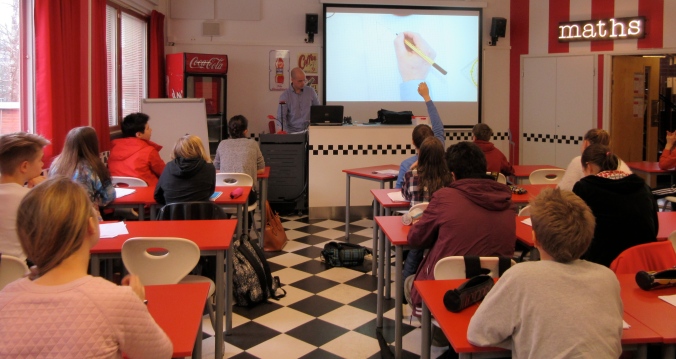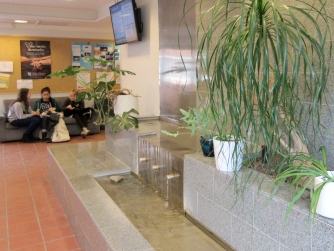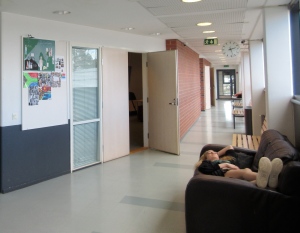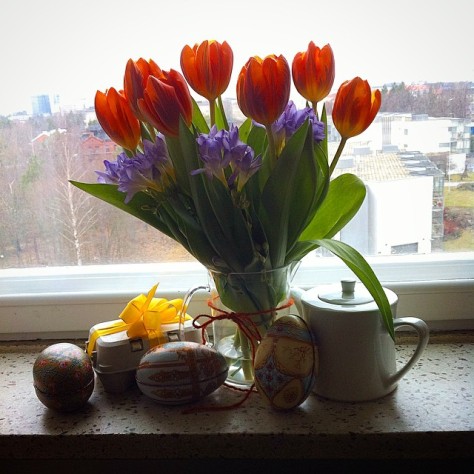When I left my 7th grade math classroom for my Fulbright research assignment in Finland I thought I would come back from this experience with more inspiring, engaging, innovative lessons. I expected to have great new ideas on how to teach my mathematics curriculum and I would revamp my lessons so that I could include more curriculum, more math and get students to think more, talk more and do more math.
This drive to do more and More and MORE is a state of existence for most teachers in the US….it is engrained in us from day one. There is a constant pressure to push our students to the next level to have them do bigger and better things. The lessons have to be more exciting, more engaging and cover more content. This phenomena is driven by data, or parents, or administrators or simply by our work-centric society where we gauge our success as a human being by how busy we are and how burnt out we feel at the end of the day. We measure our worth with completed lists and we criminalize down time. We teach this “work till you drop” mentality to our students who either simply give up somewhere along the way or become as burnt out as we find ourselves.
When I arrived in Finland I did not find big flashy innovative thought provoking math lessons. I did not find students who were better at mathematics or knew more math content. In fact the Jr. High and High school math classrooms have been rather typical of what I have experienced in Indiana. And most of the struggles (like students not remembering their basic math facts) were the same. The instruction and classroom structure of a math classroom in Finland follows the basic formula that has been performed by math teachers for centuries: The teachers go over homework, they present a lesson (some of the kids listen and some don’t), and then they assign homework. While some lectures have been wonderful and I have gotten to observe some fantastic teachers, I would say that on the whole I have seen more engaging and interactive secondary math instruction from teachers in the United States. It is rare to see a math lesson that is measurably better than those found in my district and I have seen several that were actually far worse.
So, what is the difference? If the instruction in secondary mathematics is the same or sometimes worse than those found in the US, why are Finnish students succeeding and ours are failing? The difference is not the instruction. Good teaching is good teaching and it can be found in both Finland and in the US. (The same can be said for bad teaching.) The difference is less tangible and more fundamental. Finland truly believes “Less is More.” This national mantra is deeply engrained into the Finnish mindset and is the guiding principal to Finland’s educational philosophy.
Less IS more.
They believe it. They live by it. Their houses are not larger than what they need in which to comfortably live. They do not buy or over consume. They live simply and humbly. They don’t feel the need to have 300 types of cereal to choose from when 10 will do. The women wear less make-up. The men don’t have giant trucks (or any vehicles at all, really). Instead of buying hundreds of cheap articles of clothing the Finns buy a few expensive items of high quality that will last for decades rather than months. They truly believe and live by the mentality of less is more.
Conversely in the US we truly believe “more is more” and we constantly desire and pursue more in all areas of our lives. We are obsessed with all things new, shiny and exciting and are constantly wanting to upgrade our lives. Out with the old in with the new! This mentality of “more is more” creeps into all areas of our lives and it confuses and stifles our education system.
We can’t even stick to ONE philosophy of education long enough to see if it actually works. We are constantly trying new methods, ideas and initiatives. We keep adding more and more to our plates without removing any of the past ideas. Currently we believe “more” is the answer to all of our education problems— everything can be solved with MORE classes, longer days, MORE homework, MORE assignments, MORE pressure, MORE content, MORE meetings, MORE after school tutoring, and of course MORE testing! All this is doing is creating MORE burnt out teachers, MORE stressed out students and MORE frustration.
Finland on the other hand believes less is more. This is exemplified in several ways for both teachers and students.
Less = More
1. Less Formal Schooling = More Options
Students in Finland start formal schooling at the age of seven. Yes, seven! Finland allows their children to be children, to learn through playing and exploring rather than sitting still locked up in a classroom. But don’t they get behind? No! The kids start school when they are actually developmentally ready to learn and focus. This first year is followed by only nine years of compulsory school. Everything after ninth grade is optional and at the age of 16 the students can choose from the following three tracks:
• Upper Secondary School: This three year program prepares students for the Matriculation Test that determines their acceptance into University. Students usually pick which upper secondary school they would like to attend based on the school’s specialties and apply to get into that institution. I think of this as a mixture of High School and College. (In recent years a little less than 40% choose this option.)
•Vocational Education: This is a three year program that trains students for various careers as well as gives them the option to take the Matriculation test to then apply for University should they so choose. However, the students in this track are usually content with their skill and either enter the workforce or they go on to a Poly-technical College to get further training. (A little less than 60% choose this track.)
(But wait! Shouldn’t everyone take calculus, economics, and advanced chemistry?! Shouldn’t everyone get a University degree?! No, not everyone has to go to University! Hmmm….. interesting….. What if we provided options for those who want to become successful (and very profitable) welders or electricians? What if we didn’t force students who know that their talents reside outside of the world of formal academics to take three years of high school classes that they found boring and useless? What if we allowed them to train in and explore vocations they found fascinating and in which they were gifted? What if we made these students feel valued and like they had a place in the education realm?)
• Enter the workforce. (Less than 5% choose this path)
2. Less Time in School = More Rest
Students typically start school between 9:00 and 9:45. Actually, Helsinki is thinking of creating a law stating that schools cannot begin before 9:00 am because research has consistently proved that adolescents need quality sleep in the morning. The school day usually ends by 2:00 or 2:45. Some days they start earlier and some days they start later. Finnish students’ schedules are always different and changing; however they typically have three to four 75 minute classes a day with several breaks in between. This overall system allows both students and teachers to be well rested and ready to teach/learn.
3. Fewer Instruction Hours = More Planning Time
Teachers have shorter days as well. According to the OECD (Organization for Economic Cooperation and Development) an average Finnish teacher teaches 600 hours annually or about 4 or less lessons daily. An average U.S. teacher almost doubles that teaching time with an average of over 1,080 hours of in-class instruction annually. This equals an average of six or more lessons daily. Also, teachers and students in Finland are not expected to be at school when they do not have a class. For example, if they don’t have any afternoon classes on Thursdays, they (both teachers and students) can simply leave. Or if their first class on a Wednesday starts at 11:00, they don’t have to be at school until that time. This system allows the Finnish teacher more time to plan and think about each lesson. It allows them to create great, thought provoking lessons.
4. Fewer Teachers = More Consistency and Care
Elementary students in Finland often have the SAME teacher for up to SIX YEARS of their education. That is right! The same teacher cares for, nurtures and tends to the education of the same group of students for six years in a row. And you had better believe that during those six years with the same 15-20 students, those teachers have figured out the individual instructional needs and learning styles of each and every student. These teachers know where each of their students have been and where they are going. They track the kids’ progress and have a personal invested interest in seeing the kids succeed and reach their goals. There is no “passing the buck” onto the next teacher because they ARE the next teacher. If there is a discipline or behavior problem, the teacher had better nip it in the bud right away or else deal with it the next six years. ( Some schools in Finland only loop their elementary children for three years at a time instead of six, however the benefits are still the same. )
This system is not only helpful to a child because it gives them the consistency, care and individualized attention they need, it also helps the teachers understand the curriculum in a holistic and linear way. The teacher knows what they need to teach to get them to the next step, while also giving the teachers freedom to work at the pace of their students. Teachers don’t feel the pressure to speed up or slow down so that they are “ready” for the teacher next year. Again, they are the teacher next year and they control the curriculum! They know where the kids are and what they have learned and will plan according to the students’ needs! I really believe this is a HUGE part of Finland’s success story and it does not receive enough attention.
5. Fewer Accepted Applicants= More Confidence in Teachers
So……children have the same teacher for three to six years. What if your kid gets a “bad teacher”? Finland works very hard to make sure there are no “bad teachers.” Primary education is THE most competitive degree to get in Finland. The elementary education departments in Finland only accept 10% of all applicants and turns down thousands of students annually. A person not only has to be the best and the brightest to become a primary teacher, they also have to have passed a series of interviews and personality screenings to get in. So, it isn’t enough to be the smartest in your class, you also have to have the natural ability and drive to teach.
Finland understands that the ability to teach isn’t something that can be gained from studying. It is usually a gift and passion. Some have it, some don’t. The few universities with teaching programs in Finland make sure they only accept applicants that have that gift. On top of excellent grades, and a natural disposition to be a teacher, all teachers must get a Master’s degree and write a Master’s Thesis. This generates a lot of confidence and trust in Finland’s teachers. Parents trust the teachers to be highly qualified, trained, and gifted individuals. They do not try to interfere or usurp their authority and decisions. I asked a math teacher how many emails they typically get from parents. They shrugged and answered “About five or six”. I said, “Oh, I get about that much a day too.” They then answered…”No! I meant five or six a semester!” Again, what would it be like to live in a society based on trust and respect?
6. Fewer Classes= More Breaks
As I stated before, students only have three to four (or rarely, five) classes a day. They also have several breaks/recesses/ snack times during the day and these usually happen outside come rain or shine. These 15 to 20 minute gives them time to digest what they are learning, use their muscles, stretch their legs, get some fresh air and let out the “wiggles.” There are several neurological advantages for these breaks. Study after study supports the need for children to be physically active in order to learn. Stagnation of the body leads to stagnation of the brain and unfocused, “hyper” children.
The teachers also have these breaks. The first day I was in a school in Finland a teacher apologized for the state of the “Teacher Room.” She then commented on the fact that all teacher rooms must look like this. I laughed and politely agreed, but in my head I was thinking; “What is a teacher room?” A teacher’s room is what used to be called the teacher’s lounge in the U.S…back before they went extinct. In Finland these rooms are always full of teachers who are either working, preparing, grabbing a cup of coffee, or simply resting, socializing, and mentally preparing for their next class.
Secondary level teachers usually have 10 to 20 minute breaks in between classes and often have a few skip (prep) periods as well. These rooms are different depending on the school, but from what I can tell the basic formula is a few tables, a few couches, a coffee pot, a kitchen, a selection of free fruit and snacks, and teachers to talk and collaborate with. A few of them even have massage chairs! Ha!
So, why don’t these rooms of collaboration, support and solace exist in the U.S.? We do not have TIME! Every day we teach six to seven classes in a row with no breaks. The three to five minute passing periods we do get are often used to answer emails from parents, erase the board, get ready for the next class, make copies, answer student questions, pick up the mess left behind by the students, and (heaven forbid) go to the bathroom! If we have a spare moment we are then expected to monitor the hallway because we can’t trust students to get to class without supervision. The luxury of actually sitting down for 10 minutes and enjoying a cup of coffee with some colleagues is an absolute dream, and having a day with only three classes—that is a fantasy!
7. Less Testing = More Learning
Imagine all of the exciting things you could do with your students if there wasn’t a giant state test looming over your head every year. Imagine the freedom you could have if your pay wasn’t connected to your student’s test scores. Imagine how much more fun and engaging your lessons would be!
Although it still exists, there is overall less pressure on the teacher in Finland to get through the curriculum. The teacher is simply trusted to do a good job and therefore they have more control over their classroom and its content. The teacher is able to take more risks and try new things and create exciting, engaging curriculum that allows students to become skilled individuals ready for the real world. They have time to teach skills that allow students to develop into individuals who know how to start a project and work systematically to accomplish a goal. They have time to teach craft education where students get to learn how to do real life skills like sewing, cooking, cleaning, woodworking and more! And while they are learning these amazing skills they are also learning math and problem solving and how to follow directions!
8. Fewer Topics = More Depth
I have observed several fifth through ninth grade math classes in Finland. I have looked at the curriculum covered over these five years of education and I realized that I attempt to teach the content of five years of Finnish math education in one year. Each math topic presented in every grade level I have observed here is include in my seventh grade curriculum.
Again, the American mentality of “more is more” simply does not work. If I am to get through everything I am expected to do in one year I have to introduce a new topic/lesson every other day and I always feel “behind”. Behind what, I am not sure, but the pressure is there pushing me and my students along. In Finland, teachers take their time. They look deeper into the topic and don’t panic if they are a little behind or don’t cover every topic in the existence of mathematics in a single year.
Also, students only have math a few times a week. In fact, after Easter Break, all of my seventh graders only have math ONCE a week! My heart still panics a little when I hear this! I can’t believe that is enough math time! How will they be ready for the tests?! Oh— wait. There are no tests. There is no need to rush through. The students get to actually understand the material before they are forced on to a new topic. One teacher showed me a course book and said that it had too many topics for one five week grading period. I looked at the entire book and had to stifle a chuckle because it essentially covered what would be found in ONE chapter from my textbook. Why do we push our kids in the U.S. to learn so much so quickly? No wonder they are stressed out! No wonder they give up!
9. Less Homework = More Participation
According to the OECD, Finnish students have the least amount of homework in the world. They average under half an hour of homework a night. Finnish students typically do not have outside tutors or lessons either. This is especially shocking when you realize Finnish students are outscoring the high performing Asian nations whose students receive hours of additional/outside instruction. From what I can observe, students in Finland get the work done in class, and teachers feel that what the students are able to do in school is enough. Again, there is not pressure to have them do more than what is necessary for them to learn a skill. Often the assignments are open-ended and not really graded. Yet, the students work on it in class diligently. It is very interesting to see what happens to the students when they are given something to do. The students who were not listening to the lesson at all put away their phones and start working on the task set before them. Even if it is just a suggested assignment, they give it their full attention up to the end of class. It is almost like there is an unspoken agreement: “I won’t give you homework if you work on this while you are in my classroom.” This system has really made me think about the amount of homework I assign on a daily basis.
This is obvious. If you have fewer students you will be able to give them the care and attention they need to learn. A Finnish teacher will have about 3 to 4 classes of 20 students a day- so they will see between 60 to 80 students a day. I see 180 students every single day. I have 30 to 35 students in a class, six classes in a row, 5 days a week.
 Students in Finland are incredibly independent and self motivated. When they are asked to perform a task they don’t wait for someone to tell them specifically what to do and how to do it. They don’t feign incompetency so that someone eventually does the task for them. And when something is put in front of Finnish teenagers they get started on it right away with almost a sense of relief instead of complaint. It is as if most of them were simply waiting for the teacher to stop talking so they could start the work.
Students in Finland are incredibly independent and self motivated. When they are asked to perform a task they don’t wait for someone to tell them specifically what to do and how to do it. They don’t feign incompetency so that someone eventually does the task for them. And when something is put in front of Finnish teenagers they get started on it right away with almost a sense of relief instead of complaint. It is as if most of them were simply waiting for the teacher to stop talking so they could start the work.






















